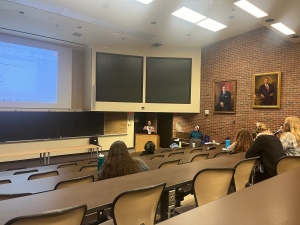By Cherie Saffold

Diana Mitrea, an expert in science communication who currently leads the scientific and corporate communications section at the biotechnology company Dewpoint Therapeutics, talked about her 20-year career in academia and industry as part of the BRET Career Development ASPIRE program’s Ph.D. Career Stories seminar series. Mitrea provided insight on how she transitioned from academic research roles to a high-level communications career in industry.
For most of her academic career and in her current role, Mitrea has worked with biomolecular condensates, which are concentrated collections of biomolecules that perform vital functions within the cell. Like the nucleolus, her “favorite condensate,” Mitrea explained that she has a vital, multifunctional role that keeps Dewpoint running smoothly. In her role, Mitrea holds educational seminars, manages scientific projects, meets with vendors, and liaises with multiple company departments.
Mitrea explained that throughout her career path, it took many attempts to find her place. As compatible biomolecules have an intrinsic ability to find each other in a sea of options, Mitrea got to where she is by following her passions and trusting her intuition.
Despite her parents wanting her to go to medical school, she pursued her passion for biochemical engineering in college, where she discovered an interest in biomedical research though a summer research internship. She combined her affinity for research and biochemistry by getting a Ph.D. in biochemistry and molecular biology from SUNY Upstate Medical University in 2009.
Her next decisions were influenced by a new phase of life: Around this time, Mitrea got married and had her first child. Keeping her family and work-life balance in mind, she worked as a staff scientist at St. Jude Children’s Research Hospital after a short postdoc. At St. Jude, she learned about the fascinating world of condensate biology, but after years gaining expertise in this field, she wanted to focus on how it could be applied to improve human health.
It was time for something new.
Mitrea joined Dewpoint, knowing it was the right move because she experienced positive interactions with the team that supported her transition to industry. From the start, they treated her as part of their team and respected her expertise. “There was this back and forth that just felt comforting,” she said. “It’s important that [teams gel] and [that] they trust each other.”
Her transition from research scientist to management was slow and subtle. Her first role at Dewpoint was in the lab as a biomolecular condensate research investigator. Over time, as she gained more experience, she naturally gained managerial and communications responsibilities. With these new responsibilities came new job titles: First, she was a biochemistry group leader, then associate director of condensate biophysics and communication, and, eventually, head of the company’s scientific and corporate communications.
The nucleolus, like all biomolecular condensates, is a sum of its parts: It is a collection of cell components that condense into a functional unit. Mitrea knew that the skills she gained throughout her education and professional experience could be condensed into an industry career in communications. To the attendees, many of them graduate students, she said, “You guys do a lot of the things that are transferable skills, but you may not know it.”
Problem solving, critical thinking, project management, and communication are all marketable skills gained by performing academic research. Like in Mitrea’s case, skills like these can be used to transition into other careers.